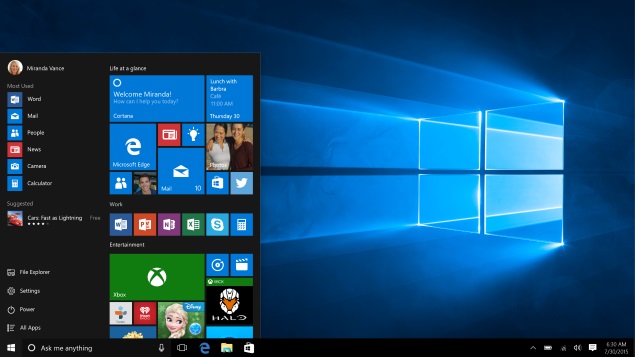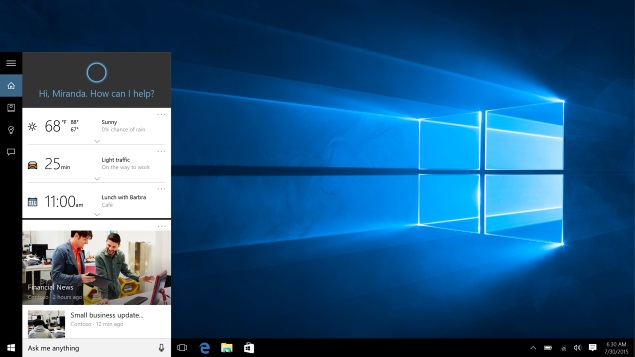It took me just a weekend to get comfortable with Microsoft's new
Windows 10 operating system, something I never did with its predecessor,
Windows 8, even after nearly three years.
With Wednesday's update, Windows no longer feels jarring, as though I'm using two different computers at once.
Best part: This update is free.
Windows
8 was Microsoft's way of modernizing personal computers, as smartphones
and tablets grew more popular. But it came across as trying to shove a
square peg into a round hole. It steered people toward tablet-like touch
commands, even on desktops and laptops that had keyboards and mouse
controls. Apps that weren't designed for touch - including Microsoft's
Office - got shoved into the basement, known as desktop mode. Desktop
mode and tablet/touch mode were like feuding siblings, each seeking to
dominate in a high-stakes tug of war.
With Windows 10, everyone
gets along. There are still separate desktop and tablet modes, but you
largely stick with one or the other depending on whether you have a
keyboard. (Microsoft skipped Windows 9, by the way, as though to
distance itself from Windows 8 and its criticisms.)
Although there
are a few reasons to hold off upgrading, which I'll explain below,
Windows 10 is better than Windows 8 in many ways:
Windows apps open as windows
Apps
for Windows 8 were designed to take up the full screen, just like
tablets. Although you could split the screen, apps could be placed only
side by side, not top to bottom, as you'd probably want when having
email and streaming video open at once.

With Mac computers and
previous versions of Windows, you can resize windows however you like.
With Windows 8, that was limited to apps that hadn't been adapted for
touch - the ones kept in the basement, segregated from the newer apps.
Windows 10 restores resizing for all apps, touch or not. It sounds
cosmetic, but it makes a big difference in fitting in with your
workflow.
Single start screen
With Windows 8, the corner
start button in desktop mode got you to a full-screen, graphical start
page in tablet mode. You had to return to the desktop mode to run an
older app, even though you were sent to tablet mode to launch it.

With
Windows 10, the start button functions the way it did with Windows 7
and earlier. The graphical start page from Windows 8 is embedded in that
start button, so that it feels modern without making you chuck old
habits. You can still get a full-screen start page, but it's not forced
on you.
Single browser
Internet Explorer is gone, replaced
by Edge. You get some functional improvements, such as a virtual marker
to draw arrows or circle an entry on a Web page to share over email,
Facebook and other means.

Even better, you no longer have separate
browsers for desktop and tablet modes. With Windows 8, when you opened a
website in desktop mode, it didn't show up in tablet mode. You had to
open it again. With Windows 10, it's a unified browser, so you pick up
where you leave off if you switch modes.
Some websites, including
those from Google, aren't as smooth on Edge as they are on other
browsers, but the problem might be limited to Microsoft's Surface
tablets. The sites work better on an HP laptop upgraded to Windows 10.
You can still get Windows 10 on Surface and install a different browser,
such as Google's Chrome.
Borrowing from phones
While Windows 8 tried too hard to adopt features from mobile devices, Windows 10 brings two features that make sense.
An Action Center offers quick access to settings such as Wi-Fi,
brightness and "quiet hours" - a way to suspend notifications and sounds
if, say, you're giving a presentation.
Cortana, the voice
assistant akin to Google Now and Apple's Siri, comes to Windows PCs.
Because you might feel awkward talking to your computer, you have the
option of typing in commands, such as "Remind me to get milk."

Cortana
is integrated with the Edge browser, too. Right-click to ask Cortana to
define a word or provide a restaurant's hours of operation. A Cortana
window temporarily slides over with that nugget of information so you
don't clutter your browser with opened tabs.
Laptops work on the go
As
Microsoft shifts its focus to online services, it has been steering
users to store files on its OneDrive online storage service. As with
Dropbox and Google Drive, OneDrive typically keeps copies of all your
files on your computer so you have them while offline. Any changes you
make sync with the service once you're back online.
That changed
with Windows 8. Copies were grabbed from the Internet only when you
needed them, which meant files weren't always available when using
laptops on the go, away from Wi-Fi. Windows 10 restores the approach of
keeping copies of everything, unless you limit that because you're low
on storage.
Should you upgrade?
I've been using a
pre-release version of Windows 10 for a month without major problems. As
with any upgrades, make sure your favorite apps and accessories will
work, as it might take time for outside developers and manufacturers to
catch up. Microsoft's Get Windows 10 app will check for known problems.
Back up your PC first.
If you're using a low-end "Home" version of
Windows, Microsoft will turn on future updates automatically once you
get Windows 10. That is normally a good thing, especially as Microsoft
plans to add features regularly, rather than wait for the next major
release. But automatic updates might surprise you with incompatible apps
and accessories.
You might want to wait a few months to see
whether these automatic updates cause any meltdowns for others. In
addition, Windows 7 users who use Windows Media Center or have DVD
players might need to find replacement software first. The free Windows
10 offer is good for a year, so there's no rush.
The case is
easier for those using Windows 8, including the Home version. The
experience is much better, making any potential upgrade hassles worth
it.
For the latest tech news and reviews, follow Gadgets 360 on X, Facebook, WhatsApp, Threads and Google News. For the latest videos on gadgets and tech, subscribe to our YouTube channel. If you want to know everything about top influencers, follow our in-house Who'sThat360 on Instagram and YouTube.
Further reading:
Cortana,
Edge,
Internet Explorer,
Laptops,
Microsoft,
Microsoft Office,
Microsoft Windows 10,
PC,
Windows 10,
Windows 10 download,
Windows 10 release date,
Windows 7,
Windows 8
 Microsoft Directed to Pay IPA Technologies $242 Million in Cortana Patent Lawsuit11 May 2024
Microsoft Directed to Pay IPA Technologies $242 Million in Cortana Patent Lawsuit11 May 2024 Halo TV Series Teaser Trailer Shows Pablo Schreiber as Master Chief, Coming to Voot Select in 202216 November 2021
Halo TV Series Teaser Trailer Shows Pablo Schreiber as Master Chief, Coming to Voot Select in 202216 November 2021 Microsoft Outlook for iOS Gets Voice Dictation for Emails, Scheduling Meetings; Android Support Coming Soon9 June 2021
Microsoft Outlook for iOS Gets Voice Dictation for Emails, Scheduling Meetings; Android Support Coming Soon9 June 2021 Microsoft's Cortana Virtual Assistant App for Android and iOS Discontinued1 April 2021
Microsoft's Cortana Virtual Assistant App for Android and iOS Discontinued1 April 2021 Microsoft Lens Is the New Name of Office Lens, First Amongst Many Mobile Productivity Changes2 February 2021
Microsoft Lens Is the New Name of Office Lens, First Amongst Many Mobile Productivity Changes2 February 2021
















